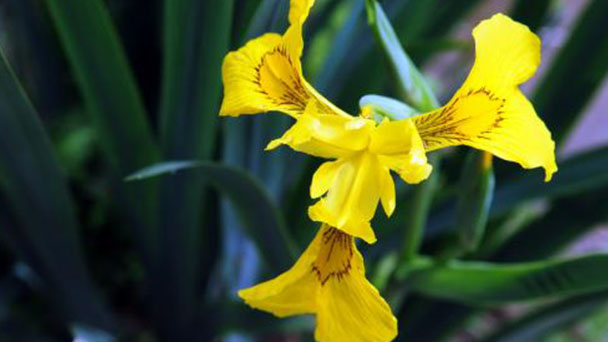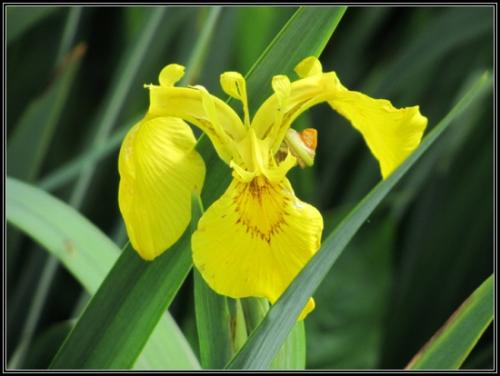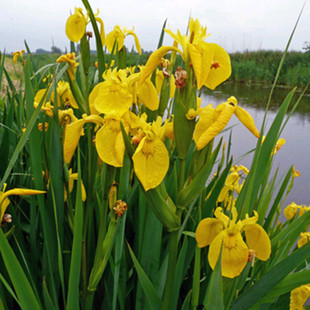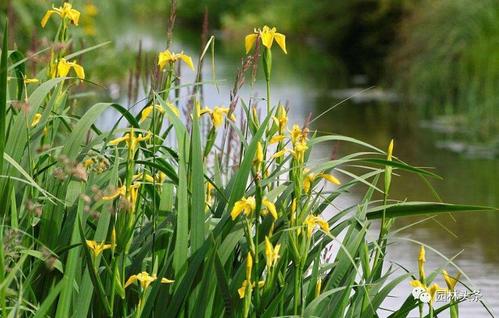How to grow and care for Yellow Iris
Written by Maggie
Dec 21 2020

Yellow Iris is a perennial wet or watery perennial herb with tall plants and short thick roots. Leaves are thick, basal, green, sword-shaped, 60-100 cm long, midribbed, with transverse reticulate veins. Stems are slightly higher than leaves, elliptic on lobes, base nearly as wide, brownish or absent, flag petals pale yellow, 8 cm in diameter. The capsule is long. There are many seeds, seeds brown, angular. Flowering period is May - June.
Yellow Iris grows in the wild on shrub margins, sunny slopes, forest margins and waterside wetlands.The planting environment is moist and well drained. Sandy loam or light clay rich in humus has a certain saline-alkali tolerance, and can grow normally in light saline-alkali soil with a pH value of 8.7 and a salt content of 0.2%. Yellow Iris is light - loving, also more resistant to shade, in the semi - shade environment can also grow normally. Yellow Iris likes warm and cool climate, strong cold resistance.

How to grow Yellow Iris
Soil for Yellow Iris
Yellow Iris can be grown both protectively and openly. Yellow Iris can be grown on any type of soil that drains well, retains moisture and is not rigid. Good soil structure is important for the growth of Yellow Iris, and sandy loam has the best cultivation effect, because sandy loam has good ventilation and water permeability, which is conducive to the expansion of Yellow Iris roots. In order to improve the structure of clay soil, plant ash, perlite, coarse sand and so on can be applied to the surface of the soil for further tillage and blending before planting. If the soil is sandy and leaks too quickly, cover the planted soil with mulch such as rice husks, pine needles and peat to alleviate the problem.
Disinfection the soil for Yellow Iris
The soil where Yellow Iris is grown is best disinfected once a year. Soil disinfecting is a very important process, usually by deep drying or chemical disinfection. The general time for deep drying is about 20 days, and chemical disinfection is generally carried out by spraying chloronitrobenzene or chlorthal nitrobenzene. Before planting, the seeds should also be disinfected and soaked in one-thousandth of chlorpyrifos or chlorothalonil solution for 30 minutes. The seeds should be disinfected and planted immediately after arrival. If not, the seeds should be stored in a well ventilated cold storage below 2°C for no more than two weeks. Too long storage will do harm to the growth of the stems and leaves in the future, and also increase the chance of the root cap being infected by penicillium.
Planting the Yellow Iris
When planting Yellow Iris, the earth temperature is required to be below 20℃. If the average temperature is expected to exceed 23℃ during cultivation, Yellow Iris cannot be planted and the planting period must be advanced or extended. If you want high quality cut flowers, it's best to use a large size seed ball, 9/10 or 10/+. The Yellow Iris ball must be planted carefully, especially when the root system has begun to grow, to avoid damage to the root system. The planting depth should be 7-10 cm from the top of the ball. Shallow-planted bulbs are easily damaged by soil dryness and prone to lodging later in the growth period. The planting density should be 80-100 bulbs per square meter
The temperature for Yellow Iris
The soil temperature after planting is very important, the lowest temperature is 5-8℃, the highest temperature is 20℃, and the optimum temperature is 16-18℃. The lowest temperature is 5℃, the highest temperature is 25℃, and the best temperature is 15℃.
Watering for Yellow Iris
Yellow Iris likes water. In the cultivation process, the soil should be kept moist, but the soil is too dry, which is not conducive to plant growth. Generally, it can be watered permeable every 10 days or so in the non-rainy season, and it can rain naturally in the rainy season. The next year early spring should be timely pouring thawing water, thawing water must be fully poured. Water must be poured once before planting to ensure that the soil is moist during planting and conducive to rapid rooting. After planting, water again to make the soil in full contact with the ball.After the soil moisture to keep wet as a standard, that is, hands hold into a group, loose do not come loose. Watering is best done in the morning. The relative humidity of the air should be maintained at 75-80%. Yellow Iris is sensitive to salt content, therefore, the EC value of irrigation water should not be greater than 0.5ms/cm.

Fertilizer for Yellow Iris
Application of base fertilizer before planting is not recommended (except for organic fertilizers) because Yellow Iris is sensitive to soil salt. Fertilization before planting will increase the salt content in the soil and hinder Yellow Iris root development. Later topdressing can be used, but Yellow Iris is sensitive to fluorine. For example, calcium superphosphate and triphosphates are prohibited, and diphosphates with low fluorine content can be used. Before planting, cow and horse manure or dried chicken manure can be applied as base fertilizer, which should be mixed well with cultivated soil after being applied. After spring planting, urea can be applied once in early summer, phosphate and potash fertilizer can be applied once in early autumn, and cow and horse manure can be applied again shallow in late autumn combined with pouring frozen water, or directly in the nursery.
Weeding for Yellow Iris
When planting Yellow Iris fields, weed control should be done in advance. In the process of planting, if weeds should be pulled out manually in a timely manner, try not to use chemical herbicides to remove weeds.
Harvest Yellow Iris
In autumn, when the flower top 3 cm below all colouring can be harvested. In spring and summer, the top of the flower can be cut off when 1 cm is unfolded. The top of the flower refers to the part of the bud that is completely colored. Pull them up by the roots and bundle them immediately after harvesting, or put them in the freezer as soon as possible. After harvesting, the bulbs are first cut off to remove long tips and aesthetically pleasing yellowish-brown leaves, then graded and bundled. The Yellow Iris should be tied in a bundle with a grade of 5 cm. The longest branch and the shortest branch should not exceed 3 cm, and the top of the flower should be aligned. Immediately after harvesting, it is sent to the cold room which is transferred to 2℃ in advance. The stems of flowers collected in autumn and winter are soft and easy to bend. After being bundled, they should be immersed in cold water at 2℃ and put in the cold room at 2℃ for at least two hours.
How to care for Yellow Iris
Southern blight of Yellow Iris
Southern blight is a common disease. The base of the stem or leaf of the main plant, in severe cases the whole plant dies. High temperature is more wet, soil is poor when the incidence of disease is high. Prevention and treatment: The rotation period should be more than 4 years. Proper ventilation to avoid overcrowding. Before the onset, spray 50% carbendazine wettable powder 500 times liquid, or 50% Tobuzine wettable powder 500 times liquid regularly.
Leaf blight of Yellow Iris
Leaf blight is a common disease, which is highly contagious and has a significant impact on the growth of Yellow Iris. Now the symptoms, occurrence rules and prevention methods are introduced as follows: the symptoms mostly start from the tip of the leaf, the early onset of the leaf tip has grayish brown disease spots or patchy dry, and then gradually to the leaf base infection, finally leading to the whole leaf scorched shape, and the appearance of black granular. Pathogenicity is the pathogen in the state of sclerotin in the soil or diseased plant residues overwintering, mid spring accompanied by rain, wind or water spread. The whole growth season can come on, 6 to September for the peak of the onset.Control methods to strengthen quarantine, do not introduce infected plants. Disinfect the soil and plants before planting. Daily maintenance shall be strengthened to prevent the planting of water. Early onset of the disease will be cut off in time, reducing the source of infection. In winter, the ground leaves are cut off and burned centrally. If there is an outbreak, 75% chlorothalonil wettable powder 800 times liquid and 70% methyl topjin wettable powder 1500 times liquid can be sprayed alternately, continuously for 4 to 5 times, each interval of 8 to 10 days.

Damping off of Yellow Iris
In plants with citrus disorder, the bulb scales become soft at the base, then appear greyish brown, covered with white mildew, and eventually decompose completely. Its pathogenicity is mainly by the spore infection, the higher the general temperature, the faster the disease development spreads .Prevention and cure method: (1) use tetra chlordane and do not rely on disinfection bulbs. (2) Use steam sterilization or potassium bromide to sterilize the soil. 3. Alternate with gladiolus and Freesia.
Root rot of Yellow Iris
It is mainly manifested in the local growth of the plant, withered flower bud, the root system is like water stain rot. Its etiology is nematode through the soil in the roots, more difficult to control. Prevention and treatment: (1) Tetrachloride + free disinfection bulb.Soil disinfection, or disinfection with 5-8 grams per square meter or 7-14 milliliters per square meter after planting. (2) Use methane bromine disinfection treatment.
Latest Updated
- Benefits of Bugleweed - 7 Science-backed Health Benefits
- Bugleweed Dangers & Side Effects - Is It Poisonous?
- How to Plant Evergreen Trees - What You Should Know
- When to Plant Evergreens - Grow Guide for Evergreen Trees
- 12 Wonderful Evergreen Shrubs for Your Garden
- 12 Popular Evergreen Plants with Pictures for Beginners
- When And How To Prune A Lilac Bush Like a Pro
- How to Grow & Care for Lilac Vine (Hardenbergia Violacea)
- Japanese Lilac Tree (Syringa Reticulata) Care & Propagation Guide
- Shumard Oak Pros and Cons - What to Know
Popular Articles
- Winter maintenance of Antirrhinum Majus
- How to Grow Terminalia Mantaly Tree
- How to Grow and Care for Crossostephium Chinense
- How to grow Antirrhinum Majus in spring
- Peristeria Elata (Dove Orchid) Profile: Info & Care Guide
- Underwatered Snake Plant (Sansevieria Trifasciata) - Signs And How To Fix
- How to Care for Brazilian Jasmine Plant (Mandevilla Sanderi)
- How to Grow & Care for Graptopetalum Purple Delight in Summer
- Rosa Chinensis (China Rose): Plant Growing & Care Tips
- How to Care for Baby Sun Rose (Aptenia Cordifolia)